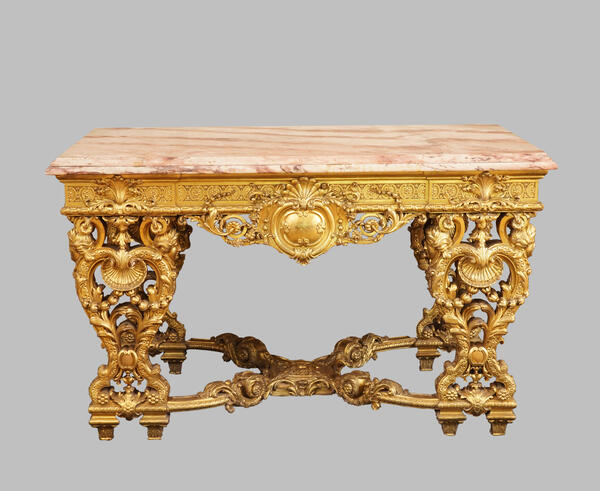The picturesque village of Severskoye is located near Kolomna. It is considered to be one of the oldest villages near Moscow. The last owner of the village was Alexander Alexandrovich Naydenov (1839-1916), a Moscow merchant and public figure. After the revolution of 1917, the Naydenov family left the estate and in the 1920s, the Severskoye recreation center named after Comrade Uryvayev was opened there. Some of the furniture of the manor was handed over to the Kolomna Museum.
The writing desk was made in Western Europe in the late 17th — early 18th centuries. It is a jewel of the exhibition. The top is made of pink marble. There is an openwork carved underframe, connecting the supports. Its floral design, rosettes and medallions are stylized as French stucco. The underframe is joined to the legs by volutes (scrolls) in the form of maiden’s profiles, resembling the figureheads on a ship’s bow. The intricately carved legs of the table continue the motif of the underframe and are connected to each other by a shaped stretcher with a carved rosette in the middle, from which four floral volutes branch off.
The furniture of the late 17th — early 18th centuries is characterized by richly developed volumetric designs and an abundance of large carvings, gilded or tinted. The carvings of shells and various scrolls in rather high relief, stylized flowers, birds and fruit, almost three-dimensional in shape, were used widely and openly. Carvings covered the legs, underframe, mirror frames, backs of armchairs, sofas and chairs.
There is often no boundary separating the ornamentation from the item itself; the entire piece becomes a collection of three-dimensional ornaments, resting on one another. In addition to Baroque designs, there are also elements of the Rococo style in the carvings: shells, scrolls and wave. But the symmetrical structure of Baroque furniture is still preserved, in contrast to the completely asymmetrical decor of Rococo furniture. The balance of the decor and the composition gives the piece poise and a sense of solidity. The desk looks monumental for its time and the carved ornamentation suggests that this piece of furniture marks the junction of two styles. It is still symmetrical Baroque, but there are already elements of early Rococo.
The writing desk was made in Western Europe in the late 17th — early 18th centuries. It is a jewel of the exhibition. The top is made of pink marble. There is an openwork carved underframe, connecting the supports. Its floral design, rosettes and medallions are stylized as French stucco. The underframe is joined to the legs by volutes (scrolls) in the form of maiden’s profiles, resembling the figureheads on a ship’s bow. The intricately carved legs of the table continue the motif of the underframe and are connected to each other by a shaped stretcher with a carved rosette in the middle, from which four floral volutes branch off.
The furniture of the late 17th — early 18th centuries is characterized by richly developed volumetric designs and an abundance of large carvings, gilded or tinted. The carvings of shells and various scrolls in rather high relief, stylized flowers, birds and fruit, almost three-dimensional in shape, were used widely and openly. Carvings covered the legs, underframe, mirror frames, backs of armchairs, sofas and chairs.
There is often no boundary separating the ornamentation from the item itself; the entire piece becomes a collection of three-dimensional ornaments, resting on one another. In addition to Baroque designs, there are also elements of the Rococo style in the carvings: shells, scrolls and wave. But the symmetrical structure of Baroque furniture is still preserved, in contrast to the completely asymmetrical decor of Rococo furniture. The balance of the decor and the composition gives the piece poise and a sense of solidity. The desk looks monumental for its time and the carved ornamentation suggests that this piece of furniture marks the junction of two styles. It is still symmetrical Baroque, but there are already elements of early Rococo.



